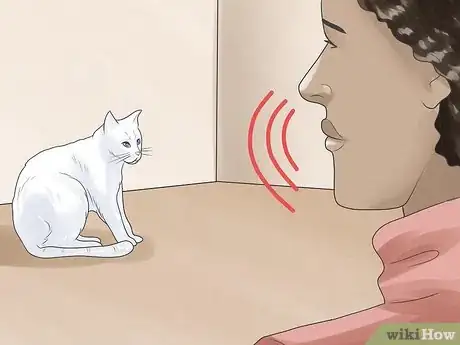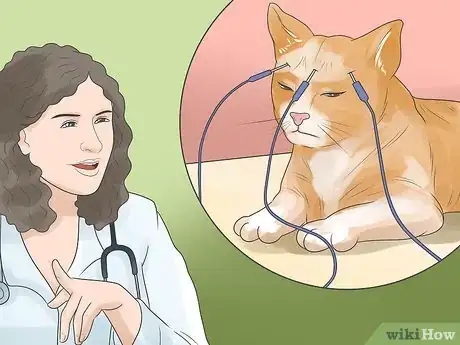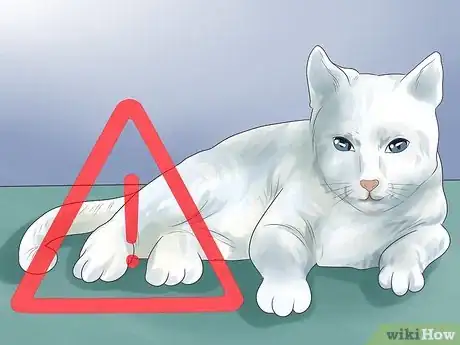This article was co-authored by Pippa Elliott, MRCVS. Dr. Elliott, BVMS, MRCVS is a veterinarian with over 30 years of experience in veterinary surgery and companion animal practice. She graduated from the University of Glasgow in 1987 with a degree in veterinary medicine and surgery. She has worked at the same animal clinic in her hometown for over 20 years.
wikiHow marks an article as reader-approved once it receives enough positive feedback. In this case, 97% of readers who voted found the article helpful, earning it our reader-approved status.
This article has been viewed 66,458 times.
If you are concerned that your cat is deaf, or going deaf, it is important that you know what signs to look for, and that you seek help from your vet. If your cat is deaf, it will be important to alter her lifestyle a bit in order to keep her out of harm’s way.
Steps
Testing for Deafness at Home
-
1Take note if your cat is less easily startled. If you notice that your cat no longer wakes up and runs away when you vacuum around her, then there is a chance that she may be deaf, particularly if she always used to run away from the vacuum (or other loud gadgets).
-
2Place your cat in a quiet room away from any distraction in order to test her hearing. Make a noise outside of your cat's visual field (so she cannot see you). One option is to bang two pan lids together. Another option is to shake the box of cat treats that your cat loves.[1]
- The most important part is to stand somewhere your cat cannot see you.
- You should also avoid standing in a position where the noise you make (such as banging to pots together) does not cause a breeze to rush over your cat.
Advertisement -
3Watch to see what happens. If your cat turns her hear to look towards where the noise came from, or reacts in some other ways (such as becoming startled), then you will know that your cat is not completely deaf.[2]
- However, you should still take your cat to a vet, as this test cannot tell you if your cat is partially deaf, or if she is deaf in one ear.
Using a Hearing Test at the Vet’s Office
-
1Understand the BAER test. The BAER (Brainstem auditory evoked response) test monitors electrical activity in the brain that is caused by auditory stimulation (such as hearing pans banging together). This test helps a vet to see if your cat’s brain has actually registered a sound, and if one or both ears are involved.[3]
- If your vet does not have BAER test equipment, ask about auditory centers that may be able to help you. Relatively few centers offer this test, so it is likely that you will need to go to a specialty center, which may be located in a different area.
-
2Be aware that your cat will have electrodes placed on her head. Three small electrodes will be attached to your cat’s head. The machine will then produce a series of clicking sounds that are generated at a range of frequencies.
- The electrodes will help to monitor your cat’s brain’s responses to the clicks.
-
3Talk to your vet about whether or not your cat will need to be sedated. Good natured cats can usually go through with a short test while fully conscious. This short test only checks to see if your cat is fully deaf or not.[4]
- A full hearing test that gives detailed answers as to the severity of the deafness, and whether or not both ears are affected, generally takes 20 to 30 minutes. Cats usually need to be sedated for this longer test.
Living With a Deaf Cat
-
1Consider alternative ways of living to keep your deaf cat safe. You may wish to consider keeping her as an indoor cat, to protect her from the hazard of traffic that she cannot hear.
- An alternative is to build a secure outdoor run so she has some access to fresh air, but won’t have access to any streets.
-
2Give your cat a playmate who is not deaf. Some cat owners have had good experiences using a normal, "hearing" cat as a playmate for the deaf cat.The body language of the hearing cat provides visual clues to the deaf cat that something has just happened.
- For instance, the hearing cat is aware ‘Mom has just opened the fridge door to get dinner out’ and rushes into the kitchen. The deaf cat, seeing his companion go, follows out of interest. This can work surprisingly well when one cat learns to take the lead. However, this depends on the two cats getting along, which cannot be guaranteed!
-
3Learn to communicate with your cat by using hand signals. Develop your own visual code for your cat, such as beckoning as a cue for your cat to come to you (reward her compliance with a treat) or by pointing to a certain spot to get her to go there and away from trouble. Reward positive behavior with a treat and she will quickly learn to obey.
- You can also stamp on the floor to create vibrations.
Understanding Deafness and the W-gene
-
1Be aware that white-coated cats are more likely to become deaf. In particular, this applies to white-coated cats (this means cats that are entirely white) whose eyes are either both blue, both orange, or one of each color. Their deafness is linked to a fault in the "W"- white coat pigment gene.
-
2Consider the percentages. It is thought that 25% of these cats are totally deaf, 50% are deaf in just one ear, and 25% have normal hearing.[5] Breeds that commonly have the W-gene include:
- White Oriental Shorthair, White Persian, White Exotic Shorthair, White Manx, White British Shorthair, White Devon Rex, White American Shorthair, White Cornish Rex, White American Wirehair, Foreign White, White Turkish Angora, European White, and White Scottish Fold.
-
3Understand that age can also play a factor. Just like humans, cats often experience at least a small amount of deafness as they get older.
References
- ↑ Deafness in blue-eyed white cats. Strain. The Veterinary Journal. 173 (3), pp 471-473
- ↑ Deafness in blue-eyed white cats. Strain. The Veterinary Journal. 173 (3), pp 471-473
- ↑ Deafness in blue-eyed white cats. Strain. The Veterinary Journal. 173 (3), pp 471-473
- ↑ Deafness in blue-eyed white cats. Strain. The Veterinary Journal. 173 (3), pp 471-473
- ↑ Hereditary deafness in the white cat. Delack. Compendium of Continuing Education for the Practicing Veterinarian 6, pp 609-619
About This Article
To tell if your cat is deaf, monitor its behavior when you do loud things that usually startle it, like vacuuming. If your cat doesn't hide or run away anymore when you do them, it could be a sign that it's deaf. You can also try standing behind your cat so it can't see you and making a loud noise to see if it responds. If it doesn't, it might be because it's deaf. In order to be certain, take your cat to see a vet and have its hearing tested. For more advice from our Veterinary co-author, like how to care for a deaf cat, scroll down.










































































